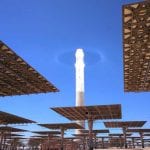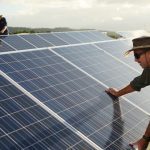Around The Web
Clean energy group refutes REC exemption in NYISO carbon pricing plan
The week in wildlife – in pictures
An anaesthetised polar bear, a surprising pine marten and a potty-mouthed parrot are among this week’s images
Continue reading...CN Markets: Pilot market data for week ending Aug. 17, 2018
World is finally waking up to climate change, says 'hothouse Earth' author
Report predicting spiralling global temperatures has been downloaded 270,000 times in just a few days
The scorching temperatures and forest fires of this summer’s heatwave have finally stirred the world to face the onrushing threat of global warming, claims the climate scientist behind the recent “hothouse Earth” report.
Following an unprecedented 270,000 downloads of his study, Johan Rockström, executive director of the Stockholm Resilience Centre, said he had not seen such a surge of interest since 2007, the year the Nobel prize was awarded to Al Gore and the Intergovernmental Panel on Climate Change.
Continue reading...Older than dinosaurs: last South African coelacanths threatened by oil exploration
Just 30 of the prehistoric fish known to exist, raising fears oil wells will push it to extinction
Bright blue, older than dinosaurs and weighing as much as an average-sized man, coelacanths are the most endangered fish in South Africa and among the rarest in the world.
Barely 30 of these critically-endangered fish are known to exist off the east coast of South Africa, raising concern that a new oil exploration venture in the area could jeopardise their future.
Continue reading...NZ Market: NZUs extend record highs again as price ceiling concerns linger
Ant Financial, BAIC Group take stakes in Beijing climate exchange
Methane offsets are getting more lucrative, but still may not spark a rush
Adani: Indigenous group loses bid to block Carmichael coalmine
Court rules in favour of mining company and orders Indigenous group to pay costs
The federal court has ruled in favour of Indian mining company Adani over a native title group seeking to block its Carmichael coal mine in Queensland’s Galilee Basin.
Members of the Wangan and Jagalingou people have been fighting against the mining company, claiming they did not give permission for the $16.5bn mine to go ahead.
Continue reading...Barnaby Joyce on the NEG
“No need for new coal:” Sun Metals formally opens solar farm in “George” town
 Premier Palaszczuk officially opens Sun Metals solar farm, the first large-scale solar farm built directly by major energy user.
Premier Palaszczuk officially opens Sun Metals solar farm, the first large-scale solar farm built directly by major energy user.
The post “No need for new coal:” Sun Metals formally opens solar farm in “George” town appeared first on RenewEconomy.
Northern Territory’s largest solar program nearing completion
 The Northern Territory’s largest solar program is heading towards completion, with work in 16 communities already finished.
The Northern Territory’s largest solar program is heading towards completion, with work in 16 communities already finished.
The post Northern Territory’s largest solar program nearing completion appeared first on RenewEconomy.
Infiniti to unveil electric speedster concept at Pebble Beach
 Infiniti, the luxury vehicle division of Japanese automaker Nissan, reveals teaser sketch of latest concept car - an eye-catching, sleek electric single-seat speedster
Infiniti, the luxury vehicle division of Japanese automaker Nissan, reveals teaser sketch of latest concept car - an eye-catching, sleek electric single-seat speedster
The post Infiniti to unveil electric speedster concept at Pebble Beach appeared first on RenewEconomy.
Shark nets to be removed from all NSW north coast beaches
Minister says nets will stay between Newcastle and Wollongong but be removed further north after trial
There are calls for shark nets to be pulled from all New South Wales beaches after the state government announced it was removing the controversial mesh on the north coast following public opposition.
On Friday the state primary industries minister, Niall Blair, said locals were unhappy about recent trials of the nets, which had proved to be less effective at catching target sharks and harmed more marine life than Smart drumlines.
Continue reading...ARENA, Finkel lead push for massive renewable hydrogen exports
 Australia has huge potential for renewable hydrogen exports, possibly requiring enough new solar and wind capacity equivalent to the existing grid by 2040.
Australia has huge potential for renewable hydrogen exports, possibly requiring enough new solar and wind capacity equivalent to the existing grid by 2040.
The post ARENA, Finkel lead push for massive renewable hydrogen exports appeared first on RenewEconomy.
Sapphire renewable energy hub wins approval – solar and storage to come
 CWP Renewables wins planning approval to add 200MW solar plus battery storage to existing 270MW wind farm at Sapphire in northern NSW.
CWP Renewables wins planning approval to add 200MW solar plus battery storage to existing 270MW wind farm at Sapphire in northern NSW.
The post Sapphire renewable energy hub wins approval – solar and storage to come appeared first on RenewEconomy.
Drought, wind and heat: when fire seasons start earlier and last longer
Enova looks to crowd to fund retail energy expansion
 Community-owned retailer launches new round of fundraising to extend its reach beyond the NSW Northern Rivers region.
Community-owned retailer launches new round of fundraising to extend its reach beyond the NSW Northern Rivers region.
The post Enova looks to crowd to fund retail energy expansion appeared first on RenewEconomy.
Video of the Day: Why the NEG will not deliver on emissions, reliability, or prices
 Senior advisor at Melbourne University's Climate and Energy College explains why the National Energy Guarantee won't deliver any of its three promises.
Senior advisor at Melbourne University's Climate and Energy College explains why the National Energy Guarantee won't deliver any of its three promises.
The post Video of the Day: Why the NEG will not deliver on emissions, reliability, or prices appeared first on RenewEconomy.
Peak EV doesn’t have to mean peak load – and here’s how to bend it
 EV charging will present challenges, and opportunities, for consumers and grid operators.
EV charging will present challenges, and opportunities, for consumers and grid operators.
The post Peak EV doesn’t have to mean peak load – and here’s how to bend it appeared first on RenewEconomy.



